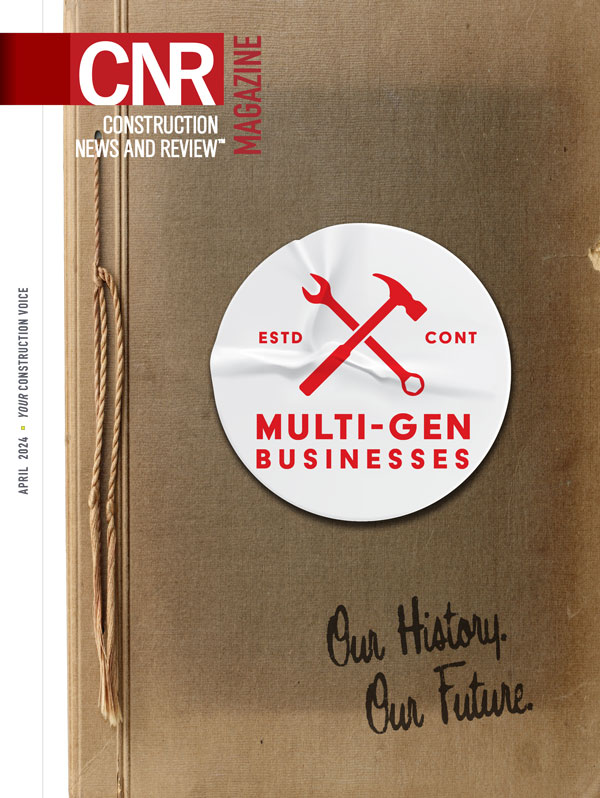How Circularity Can Reduce Waste in Construction
By STEVE CLEM
An estimated 600 million tons of debris from construction and demolition materials were generated in the United States alone in 2018, more than twice the amount of generated municipal solid waste.
This includes C&D materials such as concrete, wood, asphalt, gypsum, metals, glass, plastics and salvaged building components that are generated when structures are built or existing structures are torn down.
Circularity can help reduce waste in construction by finding ways to reuse materials after their initial life cycle comes to an end, and it must be more broadly implemented in the design and construction of buildings to create a more sustainable future.
As companies focus on tackling this sustainability challenge, the management and reduction of waste materials has become a priority, especially as population grows and housing and infrastructure are needed to support it. Enter the concept of circularity.
The concept of circularity has gained traction over the last decade as a viable cost-saving and environmental solution. The way we design buildings, the materials we use and a company’s processes to reduce waste can have a significant impact. General contractors play an important role in implementing these processes. But where do they start?
1. Focus on Adaptive Reuse vs. New Construction
Adaptive reuse means adapting existing buildings and reusing materials for new use. Building reuse will consistently result in environmental savings over demolition and new construction, when compared to buildings that are similarly used. However, designers and builders must account for the selection of construction materials to ensure they’re minimizing environmental impacts. On Skanska’s Terminal Core Redevelopment Project at the Portland International Airport (TCORE), we are expanding the entry terminal to double the size of the current ticketing and lobby area. Instead of building a new temporary bypass for travelers to walk within the airport, the team relocated and repurposed an 18,000-ton concourse connector. This enhanced the passenger experience, moved people safely around the construction area and creatively repurposed an existing structure to reduce material use and waste.
2. Be Intentional About Material Selection
Strategic selection of building materials can significantly reduce a building’s waste. It is easy to use all new materials on a new project, but if companies plan early and set targets for material reuse, they can greatly impact the sustainability of the project. By looking at materials from the perspective of circularity, we can transform the way we look at buildings.
On the Kendeda Building for Innovative Sustainable Design at the Georgia Institute of Technology’s Atlanta campus, a salvaged item was incorporated for every 500 square meters of building. The structure features 489 panels of nail-laminated timber built using 25,000 linear feet of locally salvaged two-by-fours. The 140-year-old Tech Tower provided heart pine joists that serve as treads for the Kendeda Building’s monumental staircase. The use of renewable or recyclable materials, including mass timber, minimized environmental impacts by creating less manufacturing waste and providing lower carbon-emission alternatives.
3. Design For Flexibility and Adaptability, Deconstruction
Construction companies must effectively collaborate with design partners to optimize opportunities for modularity and deconstruction. Modularity allows project teams to manufacture components of a structure at an off-site manufacturing facility and then assemble them on site. Designing for manufacturing reduces waste through automation and material optimization. Deconstruction allows teams to take apart components of a building to reuse them. Designers and contractors can reduce a building’s size – and therefore the use of materials – by creating spaces that can be used for multiple purposes or converted to different functions. Thinking about modularity and deconstruction allows us to build with the intention to dismantle and reuse parts in the future instead of using new materials.
For example, developers are increasingly requesting designs that account for future flexibility in above-grade parking, as they anticipate less dependence on personal vehicles. By adding speed ramps and flat floors plus a taller floor-to-floor height, buildings can be flexibly used for office or residential spaces. It is important to consider how the initial build could affect future use, so adaptive reuse is a greater possibility.
4. Get Creative With Waste Management
Reducing the amount of construction and demolition materials that end up in landfills is an important part of waste management. Certain construction materials can be recycled or repurposed, but not all markets have robust waste management systems in place. This means companies must innovate ways to keep materials out of landfills. Contractors with ambitious landfill waste diversion goals can establish plans that outline how they will separate materials on site, reduce shipping and packaging materials and when needed, look outside the normal channels for waste management.
At our Gulf State Park Lodge project in Alabama, we did just that. Five tons of gypsum drywall were produced weekly. Because there are not any gypsum drywall recycling facilities located near the site, the Skanska team relentlessly pursued a sustainable solution for recycling the estimated 120 tons of gypsum board waste collected. Industry wide, it is estimated that 10 percent of the gypsum board necessary for a new building ends up as scrap. The team’s research revealed that when ground up, gypsum board products are an agricultural soil amendment for peanut farming – a method that has been used for more than 250 years.
So, after petitioning the US Dept. of Agriculture and receiving approval to provide the ground gypsum to local peanut farms, Skanska reached out to local farmers who enthusiastically agreed to accept the ground gypsum board waste to spread throughout their fields and till as a soil conditioner. This was an ingenious solution that benefited both Skanska and local farmers.
Future Outlook
Circularity can help reduce waste in construction by finding ways to reuse materials after their initial life cycle comes to an end. This is not a new concept, but one that must be more broadly implemented in the design and construction of buildings to create a more sustainable future. By focusing on adaptive reuse versus new construction, being intentional about material selection, designing for flexibility, adaptability and deconstruction, and by getting creative with waste management, the construction industry can help reduce waste while protecting our natural resources. It will take effort, but with the right strategies, we can spur action and innovation that moves the needle in a positive direction.
Steve Clem is senior vice president of sustainability at Skanska USA Building, one of the world’s largest development and construction companies. Clem is responsible for setting and achieving Skanska’s decarbonization goals in the United States and works with construction teams to identify sustainable procurement solutions for clients.
Fresh Content
Direct to Your Inbox

YOUR CONSTRUCTION VOICE IN ST. LOUIS AND BEYOND
Join CNR Magazine today as a Content Partner
As a CNR Content Partner, CNR Magazine promises to support you as you build, design and engineer projects not only in and around St. Louis, but also across the U.S. CNR is equipped and ready to deliver a dynamic digital experience paired with the top-notch, robust print coverage for which you’ve always known and respected the magazine.





